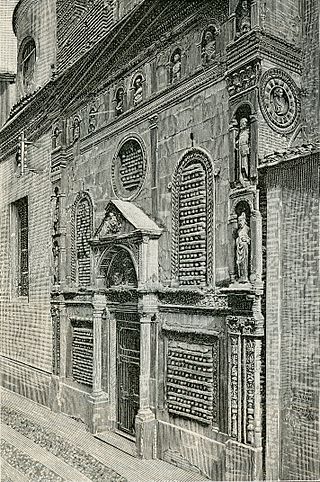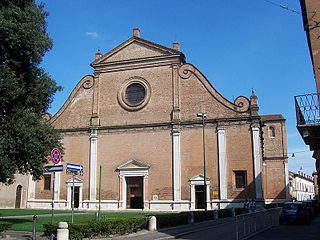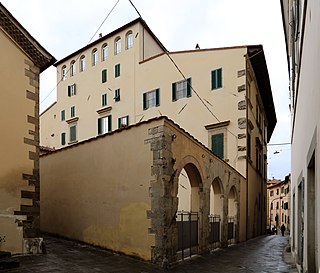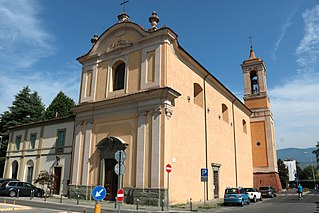
San Francesco is a Gothic-style, Roman Catholic church located on the piazza of the same name in Pistoia, region of Tuscany, Italy.

San Francesco is a Gothic-style, Roman Catholic church located on the piazza of the same name in Pistoia, region of Tuscany, Italy.
According to tradition, St Francis had visited Pistoia in 1220. Soon after, a few adherents of St Francis had grouped themselves in a small monastery attached to a small church called Santa Maria del Prato or Santa Maria Maddalena, located at about the location of the present church. The property appears to have been granted to them by the canons of the cathedral. As the monastery grew, a new church, representing the present structure, was begun by 1294, dedicated to the Holy Cross, and manned by the Order of Friars Minor Conventual. While the single nave structure with a number of lateral altars was completed by 1340, modifications and refurbishment proceeded for centuries. The lateral windows are thin and tall. The facade was only added in 1707.
The convent was suppressed in 1808 by the Napoleonic government, but the friars were allowed to return in 1819. In 1866, the monastery was again suppressed, this time by the Italian State and its buildings passed into property to the Commune. In 1926 the convent was again returned to a community of conventual friars. [1] In 2016, the Franciscans ceded the property and church to the Congregation of the Sacred Heart of Jesus of Betharram.
The description of the interiors in 1853 by Tigri, recalls the following interior decoration: [2] To the right of altar from entrance
In the presbytery
On the left of the altar
Other chapels had frescoes by Nanni di Jacopo and Bartolomeo di Giovanni Cristiani, Bonaccorso di Cino and the master of the Bracciolini Chapel. In the chapter hall are 13th-century frescoes attributed to Antonio Vite. [3] A polyptych at this church by Lippo Memmi depicting Virgin between St. Paul, St. John the Baptist, St. James, St. Francis, St. Louis, St. Mary Magdalen, and Santa Chiara was described by Vasari, but is no longer present. [4]

San Francesco a Ripa is a church in Rome, Italy. It is dedicated to Francis of Assisi who once stayed at the adjacent convent. The term Ripa refers to the nearby riverbank of the Tiber.

Santa Maria dei Miracoli and Santa Maria di Montesanto are two churches in Rome.

San Francesco da Paola ai Monti is an 18th-century titular church in Rome. It is dedicated to St Francis of Paola, the founder of the Order of Minims, whose friars serve this church and whose Generalate is attached to it, and is located in the Monti rione.

The Basilica della Santissima Annunziata del Vastato is the Catholic cathedral of Genoa, northern Italy; its decoration employed the major baroque studios and artists in Genoa in the 17th century.

Lippo Memmi was an Italian painter from Siena. He was the foremost follower of Simone Martini, who was his brother-in-law.

San Francesco della Vigna is a Roman Catholic church in the Sestiere of Castello in Venice, northern Italy.

The Basilica of San Domenico, also known as Basilica Cateriniana, is a basilica church in Siena, Tuscany, Italy, one of the most important in the city. The basilica is an example of Cistercian Gothic style.

San Gaetano, also known as Santi Michele e Gaetano, is a Baroque church in Florence, Italy, located on the Piazza Antinori, entrusted to the Institute of Christ the King Sovereign Priest.

San Paolo is a Roman Catholic church located on Via della Rosa #39 in Pistoia, region of Tuscany, Italy. The eclectic church facade sits near the intersection of four streets: Corso Silvani Fedi, Corso Giovanni Amendola, Via Porta Carratica, and Via del Can Bianco, about a block away along Silvani Fedi from the Chiesa del Tau.

Pistoia Cathedral, or Cathedral of Saint Zeno is the main religious building of Pistoia, Tuscany, central Italy, located in the Piazza del Duomo in the centre of the city. It is the seat of the Bishop of Pistoia and is dedicated to Saint Zeno of Verona.

San Bernardino is a church in Verona, northern Italy. The church, in Gothic style, was built from 1451 to 1466.

The Palazzo Comunale, also known as the Palazzo del Popolo of San Gimignano has been the seat of the civic authority in the comune since the 13th century. It is located on the Piazza del Duomo close to the Collegiate Church of the Assumption of the Blessed Virgin Mary. The building and Collegiate Church are at the heart of the medieval town, and are part of the UNESCO World Heritage Site of the "Historic Centre of San Gimignano".

The Basilica of Our Lady of Humility or Basilica della Madonna dell'Umiltà is a Renaissance-style Roman catholic church building in Pistoia, Italy.

The Madonna di Galliera is a church with a Renaissance facade and Baroque interiors, located on Via Manzoni, in central Bologna, Italy. It stands in front of the Palazzo Ghisilardi Fava. The present name over the portal is the Chiesa di Filippini Madonna di Galliera e Filippo Neri.

San Francesco is a late-Renaissance, Roman Catholic minor basilica church located on via Terranuova in Ferrara, Emilia-Romagna, Italy.

The Palazzo Sozzifanti also known as the Palazzo Buontalenti is a Renaissance-style palace located at the intersection of Via del Carmine, Via de' Rossi, Via Abbi Pazienza and Via Sant'Andrea in central Pistoia, Tuscany, Italy. The palace is used in 2019 as a temporary exhibition site by the Cassa di Risparmio di Pistoia and Pescia Foundation.

The Palazzo degli Anziani also known as the Palazzo del Comune, della Comunitá or del Giano is a Gothic-style stone palace located in the ancient historic center of Pistoia, Tuscany, Italy. The palace served as city hall for centuries; it still belongs to the comune and now mainly houses the Museo Civico d'Arte Antica.

Santa Maria del Carmine is a Baroque-style, deconsecrated Roman Catholic church in Pistoia, region of Tuscany, Italy.

The church and convent of the Santissima Annunziata is a Baroque-style, Roman Catholic church located on Piazza de Servi #4, Pistoia, region of Tuscany, Italy. The convent presently functions as a warehouse. The church is down via Laudesi from the San Desiderio, and via Piazza de Servi, From San Giovanni Decollato.
The Palazzo del Priorino is a Baroque-style palace on Via Pacini in central Pistoia, Tuscany, Italy.